Best bike travel cases: Bags, boxes and cases that will protect your bike when you fly
The best bike bags to protect your pride and joy from heavy-handed baggage handlers
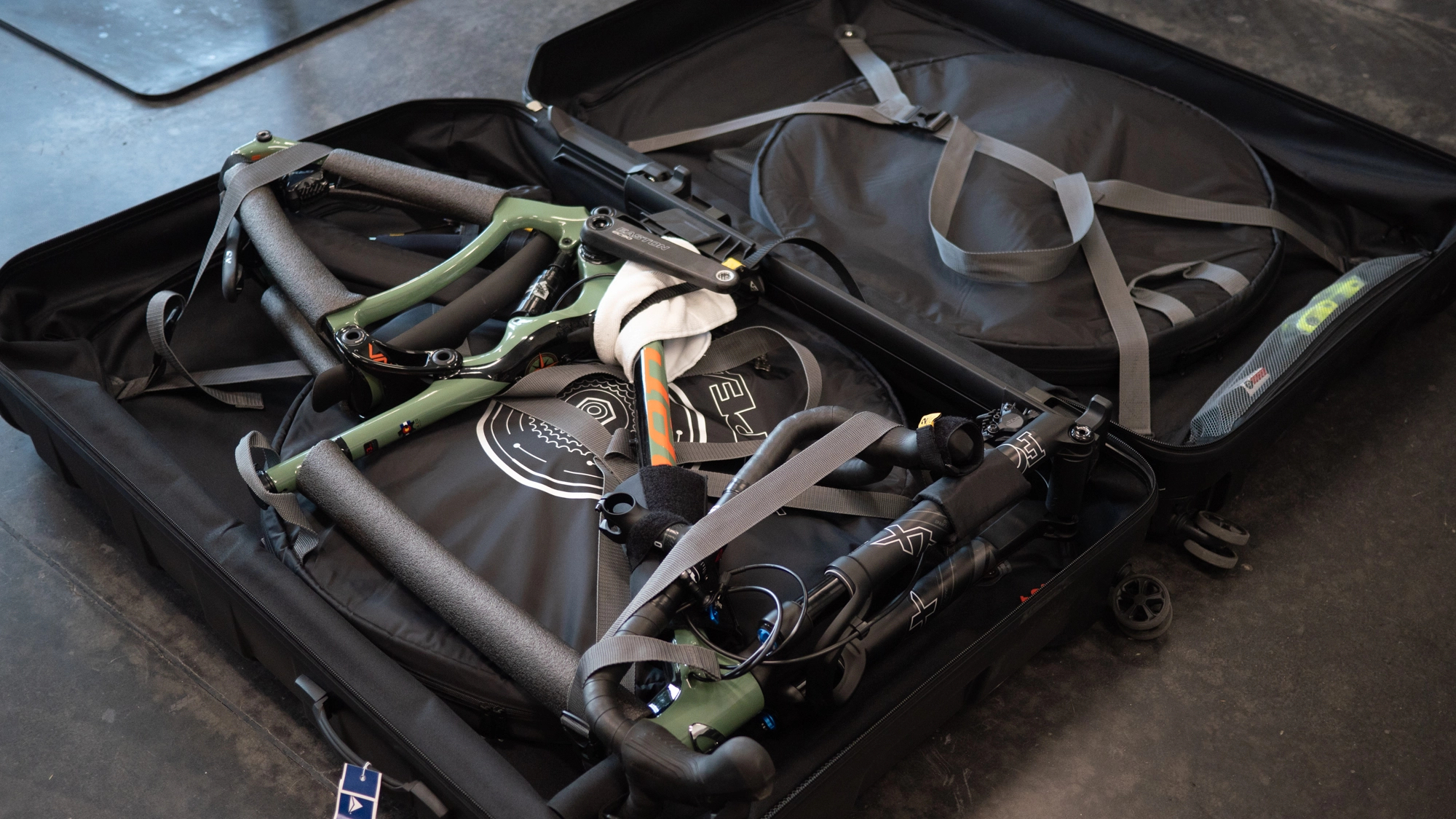
The best bike bags, bike boxes and travel cases for bikes are incredibly well-designed these days.
Many cyclists travel abroad with their bikes for holidays or to compete. This means flying with your bike, which can be a daunting proposition. Most of us have heard horror stories of riders opening their bike bag to find a damaged bike inside after a flight. Choosing the right bike bag, rigid travel case or box will ensure your bike is protected and make your journey easier, meaning you can relax and enjoy your trip.
Another thing you might want to consider while travelling with your bike is an insurance option. Even with one of the best bike bags things do occasionally happen, so if the unthinkable happens and your bike doesn't arrive in one piece, you'll want to have insurance in place to help ease the blow. We have a list of the best bike insurance options, some of which cover your bike even when travelling.
We have flown with many of the bike bags in this guide so that we can properly review packing procedures and durability on a flight. Our favourite bike bag is the Evoc Road Bike Bag Pro due to its internal structure and easy packing procedure, but there are plenty of other options worth considering. Keep reading to see our pick of the best bike travel cases plus advice lower down the page on how to choose the best bike travel case for your needs.
Last updated on 11th July 2025
Added links to new reviews and Buy If/Don't Buy If advice.
Best bike bags, travel cases and boxes: quick list
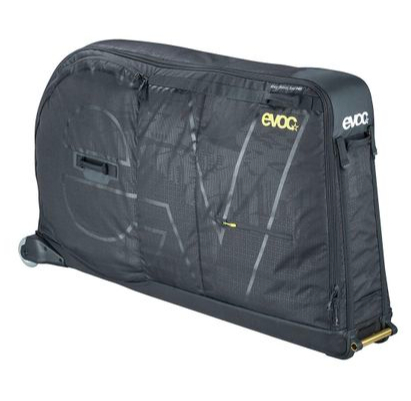
The Evoc Pro holds a road bike with pedals and wheels removed. A hard upper section adds protection.
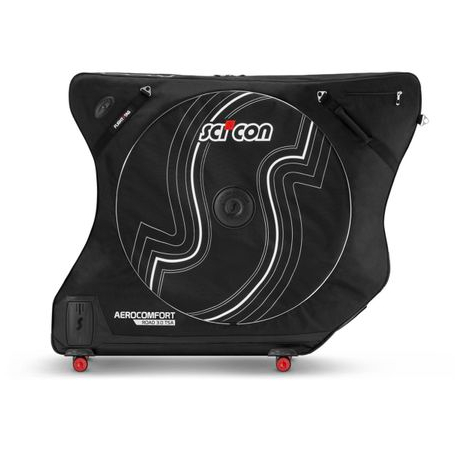
Popular with the pros, the Scicon AeroComfort just needs you to remove your wheels to be ready to go.

Bike Box Alan's largest box, the Tri Aero Easyfit will accept bars up to 50cm wide without disassembly.
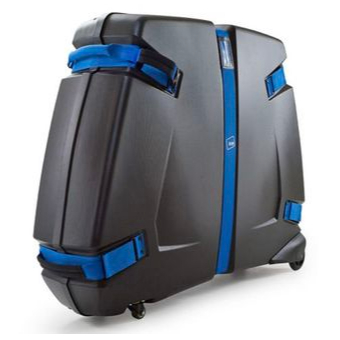
This B&W box makes packing easy, it closes with velcro and there are no latches or hinges to break.
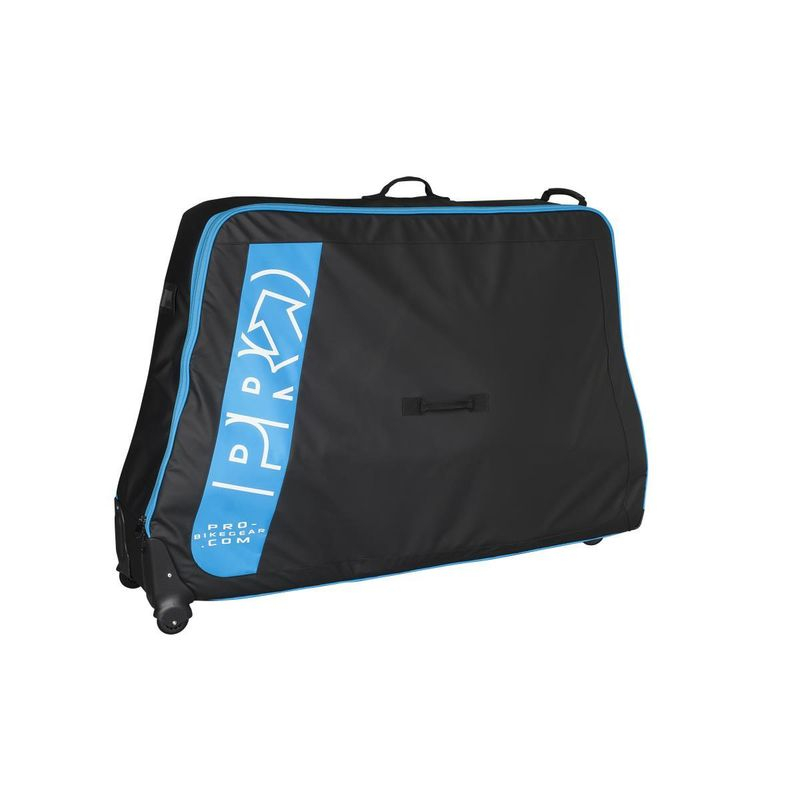
Very large capacity means that this PRO bike bag can fit any type of bike with room to spare.

Bikes need disassembly to pack, but this Thule bag has an integrated workstand to make reassembly easier.
Best bike bags, travel cases and boxes
You can trust Cyclingnews
Best for road bikes
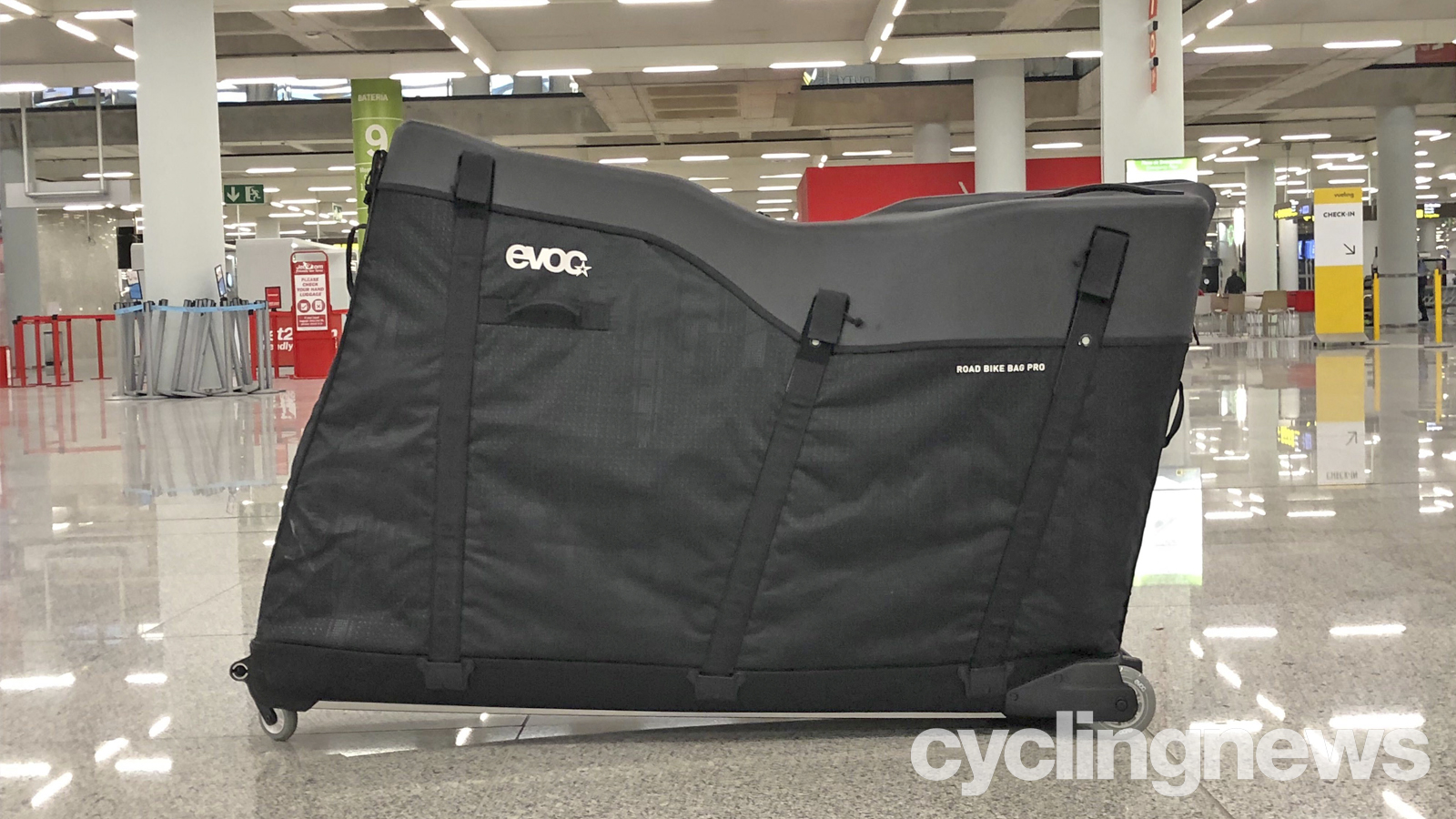
Specifications
Reasons to buy
Reasons to avoid
✅ You want good protection without too much weight: A soft middle section keeps weight down, while a hard top section protects
✅ You want easy packing: Just the pedals and wheels need removing
❌ You want easy manoeuvrability: The single front wheel and fixed rear wheels can make moving the loaded bag around tricky
❌ You want a lower price: Evoc's bag is towards the expensive end of the price range
The Road Bike Bag Pro pairs a soft lower and hardcase upper to offer protection without being too heavy. It includes an aluminium tray inside that attaches to the axles of the bike inside the bag, holding it secure and out of harm's way when in transit. This can double up as a workstand too, if you remove the pedals.
I found packing to be a straightforward process with only the pedals and wheels needing to come off, although some riders might need to lower their saddles too. Then the frame is secured with a range of Velcro straps and purpose-built padding. The wheels go into individual wheel bags and there is a padded section to protect the handlebars.
There's plenty of space to fill with kit, which doubles up as extra protection. I stored tools and pedals in the internal pockets for tools and pedals to stop them from moving around and causing damage. There's an external pocket for the front wheel, which can be removed to prevent damage in transit.
Two fixed rear wheels and the front trolley wheel make manoeuvring the loaded bag pretty easy, although the single front wheel can have a habit of tipping over if pulled in the wrong direction. Evoc has added plenty of handles to help move the bag around.
If you want to see how easy it is to pack a bike into the Evoc Road Bike Bag check out our Instagram reel for how quickly Josh can unpack his bike for proof.
Read more details in our full Evoc Road Bike Bag Pro review.
Best for minimal disassembly
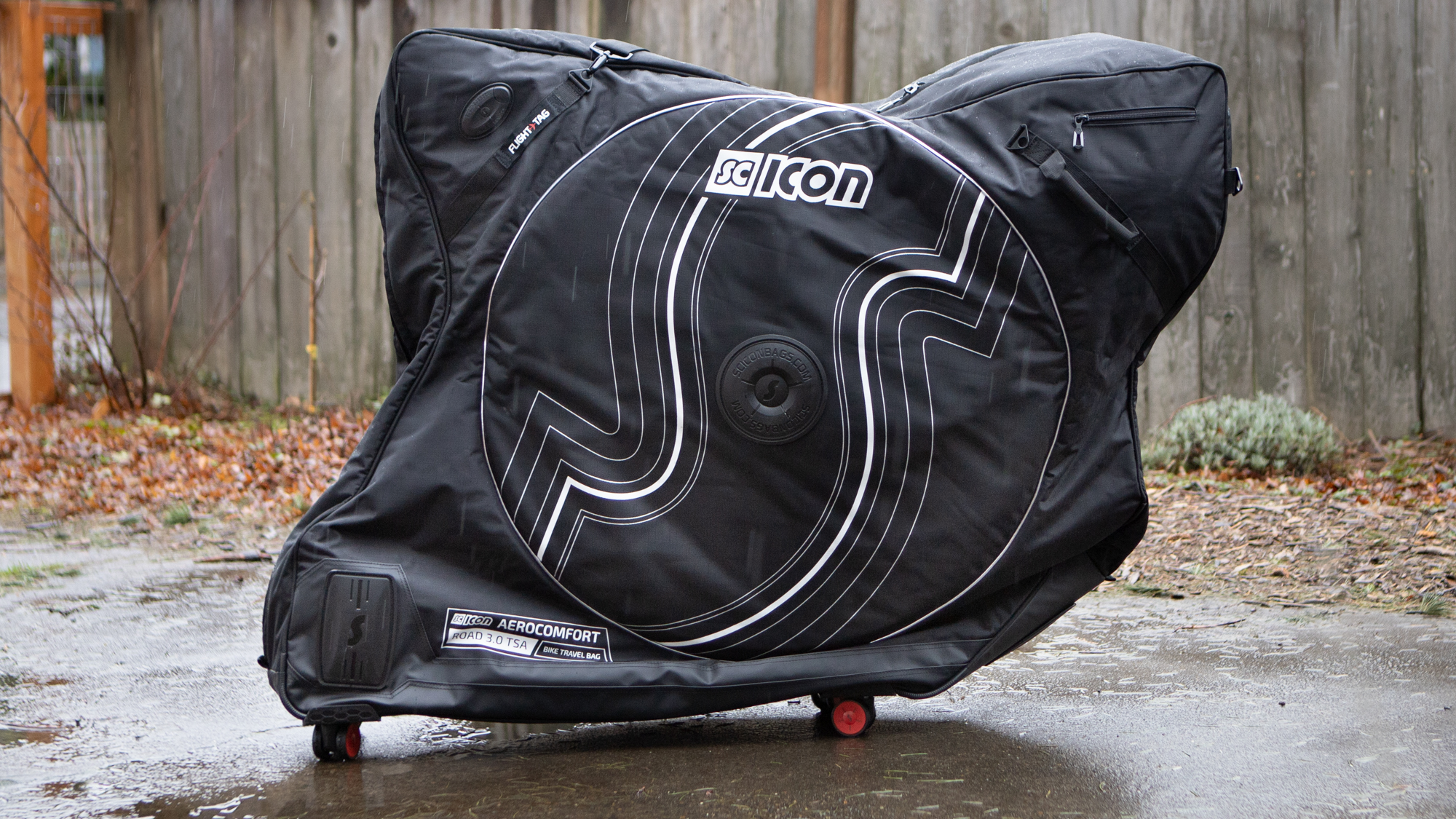
Specifications
Reasons to buy
Reasons to avoid
✅ You want the easiest packing: Just the wheels need to come off
✅ You want padding and accessories: There's plenty of padding included and you can buy extras like a derailleur protection
❌ You want compact luggage: The minimal disassembly results in a large box
❌ You want a box that doesn't drift: The four casters can make moving the bag around awkward, particularly on sloping surfaces
The beauty of the Scicon AeroComfort 3.0 TSA is that you can pack your bike without turning a single bolt (unless you have thru-axles); all you have to do is remove the wheels.
Once attached to the rigid Frame Defender metal base, my bike slotted in securely using the quick-release or thru-axles. Along with the square metal tube internal structure, Scion includes plenty of additional padding and a gear bag that's secured to the base under the downtube for all the sundries you need at your riding location.
The bike straps into the bag securely, and the 360-degree wheels allow for easy one-handed dragging of the combined 9kg bag and bike weight. Although the four wheels limit the risk of toppling, all the wheels are casters so it tends to drift a little on uneven surfaces. We’ve also seen baggage handlers stack Scicon bags upside down on baggage carts on multiple occasions so they won’t roll away, so consider some additional padding for your handlebars and shifters.
Read more details in our full Scicon AeroComfort 3.0 TSA review.
Best for integrated handlebars
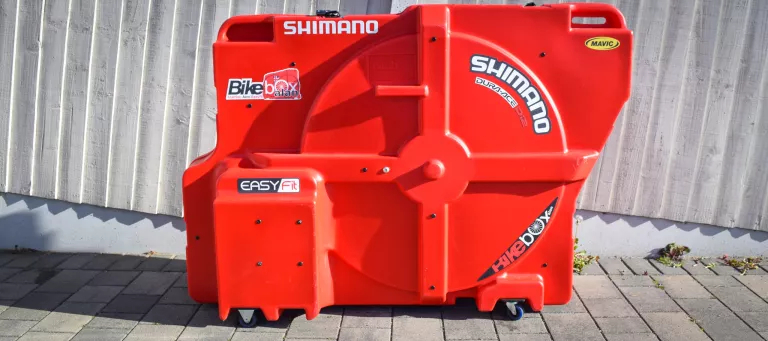
Specifications
Reasons to buy
Reasons to avoid
✅ You have tri bars: There's room for a tri bike in the box without removing the bars
✅ You want a rigid box: The Bike Box Alan range is fully rigid, which should offer more protection in transit
❌ You want something smaller: Getting the box to and from an airport can be tricky
❌ You want easy storage: You'll need considerable room to store the box between uses
Bike Box Alan makes a number of hardcase bike boxes in Yorkshire, UK. The Triathlon Aero easy fit is the largest bike box the company produces and with a max width of 50cm, there is no need to disassemble the front end of your bike to pack it into the box.
All that is required to pack a bike is to remove your wheels and pedals and you're good to go, making this box a great option for time trial or triathlon bikes, road bikes with more complex integrated handlebars or cable routing or for people who just don't want the extra hassle. Everything is held in place with some of the grippiest Velcro I have ever encountered, with the wheels stored away in their own dedicated spot. Unlike some bags where there is some trepidation about leaving things like derailleurs on the bike, I was confident leaving my rear mech and hanger fitted to the bike.
To be able to fit the bike in the box with the handlebars fitted means the case is considerably wider than most other bags and cases. That means you need to factor this in when organising transport to and from the airport. The wheels work well so rolling the case around was easy enough.
The boxes are available in six different colours; we tested the red version. You can also choose customisable stickers and the box carries a 7-year manufacturing warranty as well as a range of spare parts.
You can read more details in our full Bike Box Alan Triathlon Aero Easyfit review.
Easy to manoeuvre
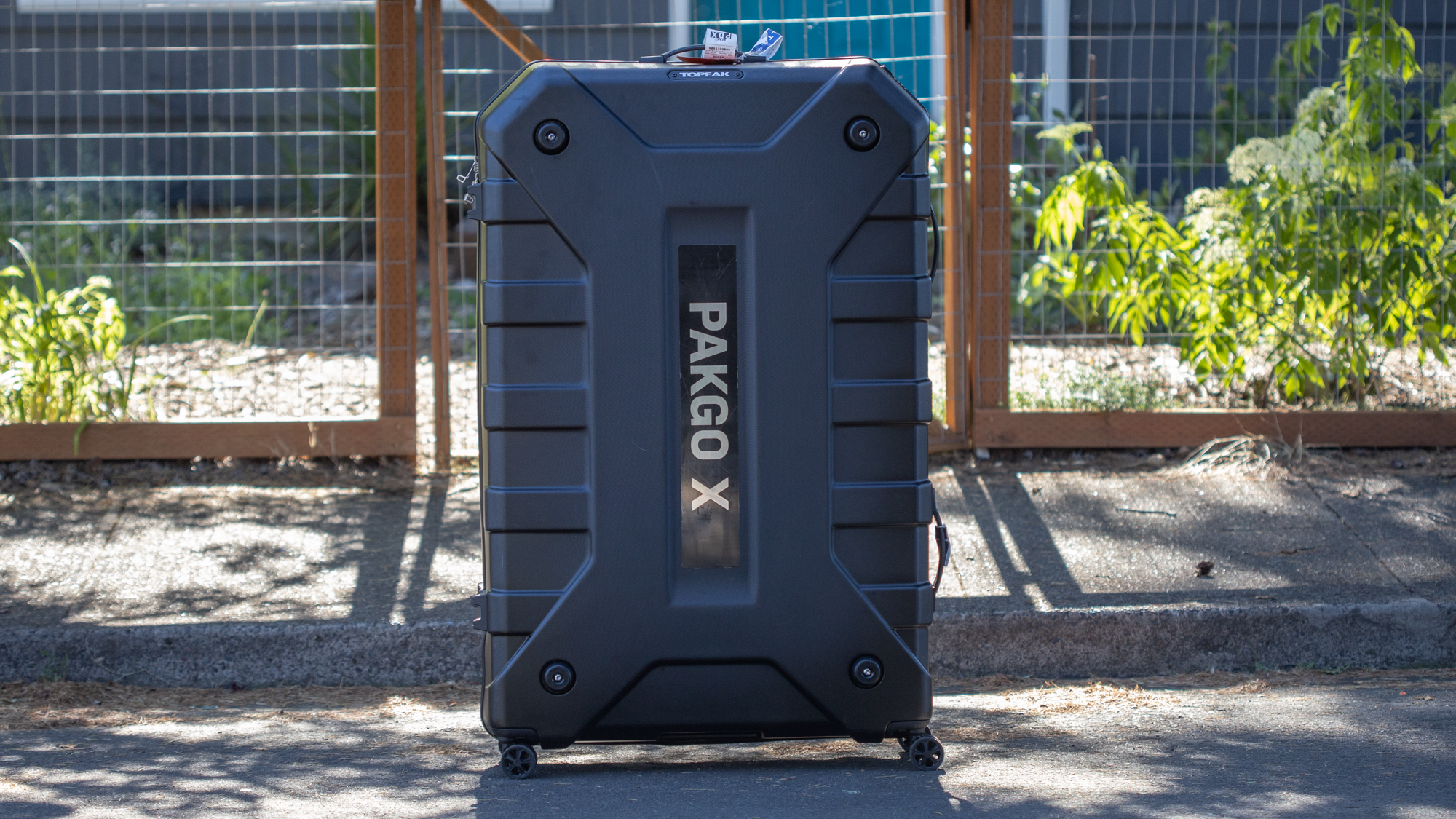
Specifications
Reasons to buy
Reasons to avoid
✅ You want easy manoeuvring: The tall rather than long shape makes moving the packed case around easier
✅ You want good protection: As with the Bike Box Alan, the rigid case is more protective than a soft case
❌ You don't want to disassemble your bike: Topeak's case requires significant tool work to pack
❌ You want to avoid overweight fees: The case alone weighs almost 13kg
The Topeak PakGo X is a bit like the kind of carry-on luggage you'd recognise on every flight, except it's super-sized. Once packed, the bike sits with the fork facing the ground and the tail of the bike up in the air. This means a more upright outer silhouette that's easier to manoeuvre.
More important than the orientation of the bike though, is the well-thought-out protection. There are a number of protective elements and each one has a label on it. As I packed my bike it was easy to find which piece goes where and every part of the bike is both protected and securely held to avoid movement in transit. You will need to remove the bar and stem, saddle and seatpost, rear derailleur, and wheels but there's a place for everything.
The one thing I had to be aware of was the weight of the case. Topeak lists the weight as 10 Kg for the case only but that's not how you'll use it. Instead, you'll want to look at the 12.8 Kg weight that includes all the protective pieces. Unless you have a lightweight road bike, it's unlikely you will avoid overweight fees.
Read more details in our full Topeak Pakgo X Bike Carrier review.
Best budget bike box
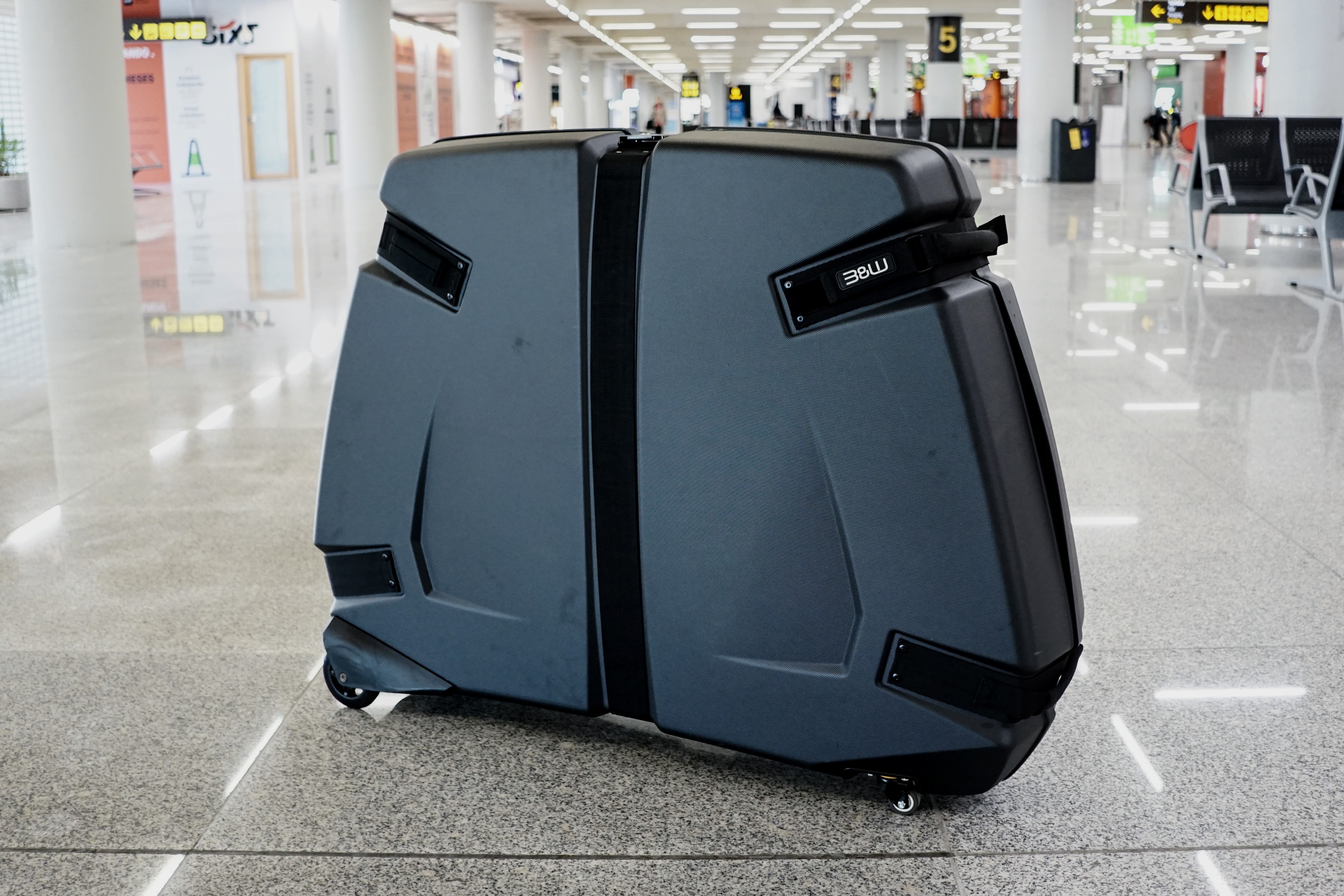
5. B&W International Bike Box II
Specifications
Reasons to buy
Reasons to avoid
✅ You want a simple design: With no hinges and velcro straps, there's less to break
✅ You want good manoeuvrability: The B&W case is easy to move around
❌ You want a box that is ready to go: It took us around an hour to mount all the box's interior hardware
❌ You don't want to disassemble your bike: There's a bit of work required to get your bike ready to travel
Sometimes simple is best, and that's precisely what the B&W International Bike Box II has to offer. There are no complicated packing procedures - instead, you get a few layers of foam to protect the frame from the wheels and box, and it all fits inside two interlocking plastic sides.
The clamshell design utilises five self-tightening Velcro buckles to prevent the case from slipping open, and it features a surprising number of handles given the design. B&W International has updated the case with a new plastic designed to flex and not crack, and there are no latches or hinges to break.
With room for up to a 62cm frame, the case rolls on four wheels, two fixed and two free-rotating and weighs 11kg with the included padding.
We found that there's a little assembly required to get the box ready to use, requiring sockets and a screwdriver and then there's the disassembly of the bars needed to pack the bike in the box. Larger road bikes fit, but the box may be too small for a mountain bike.
It's a box that we found easy to move through an airport with, thanks to the four wheels. It protected the bike well and the case is robust. It's low-priced for a hard case too.
Read more in our B&W International Bike Box 2.0 review.
Best for MTB and Road
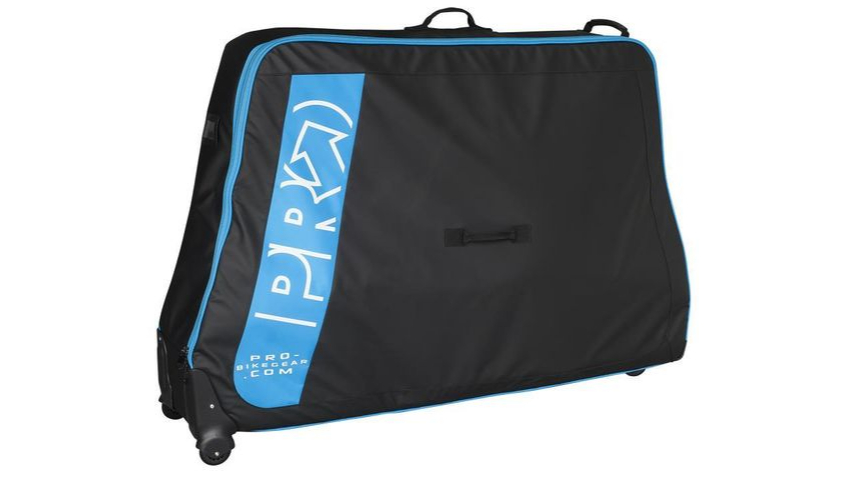
6. PRO Bike Travel Case
Specifications
Reasons to buy
Reasons to avoid
✅ You travel with TT or MTBs: There's plenty of room here for mountain bikes or tri bars, not just road bikes
✅ You want low weight: At just over 8kg, the Pro bag is lighter than many
❌ You want more protection: The soft upper case doesn't shield your bike as well as many alternatives
❌ You want easier transit: The non-rigid design can make moving the case awkward
With room to easily swallow road, TT and mountain bikes, the Pro Bike Mega Case is huge and features an aluminium base frame which connects to your bike at the axles. With so much room inside the case, the seatpost doesn't need to be removed, just lowered, and in most cases, you can get away with simply spinning your bars.
The inside of the bag has plenty of well-padded provisions to hold your frame securely, and even with the four 360-degree wheels at the bottom, the bag tracks easily in a straight line, but it can be cumbersome in crowded baggage claim areas or train stations.
The outer fabric seems to mark a bit in transit, however, it's robust and weighing a hair over 8kg, you should be able to get your bike and a bit of extra gear inside before you tip into overweight baggage territory.
Integrated repair stand
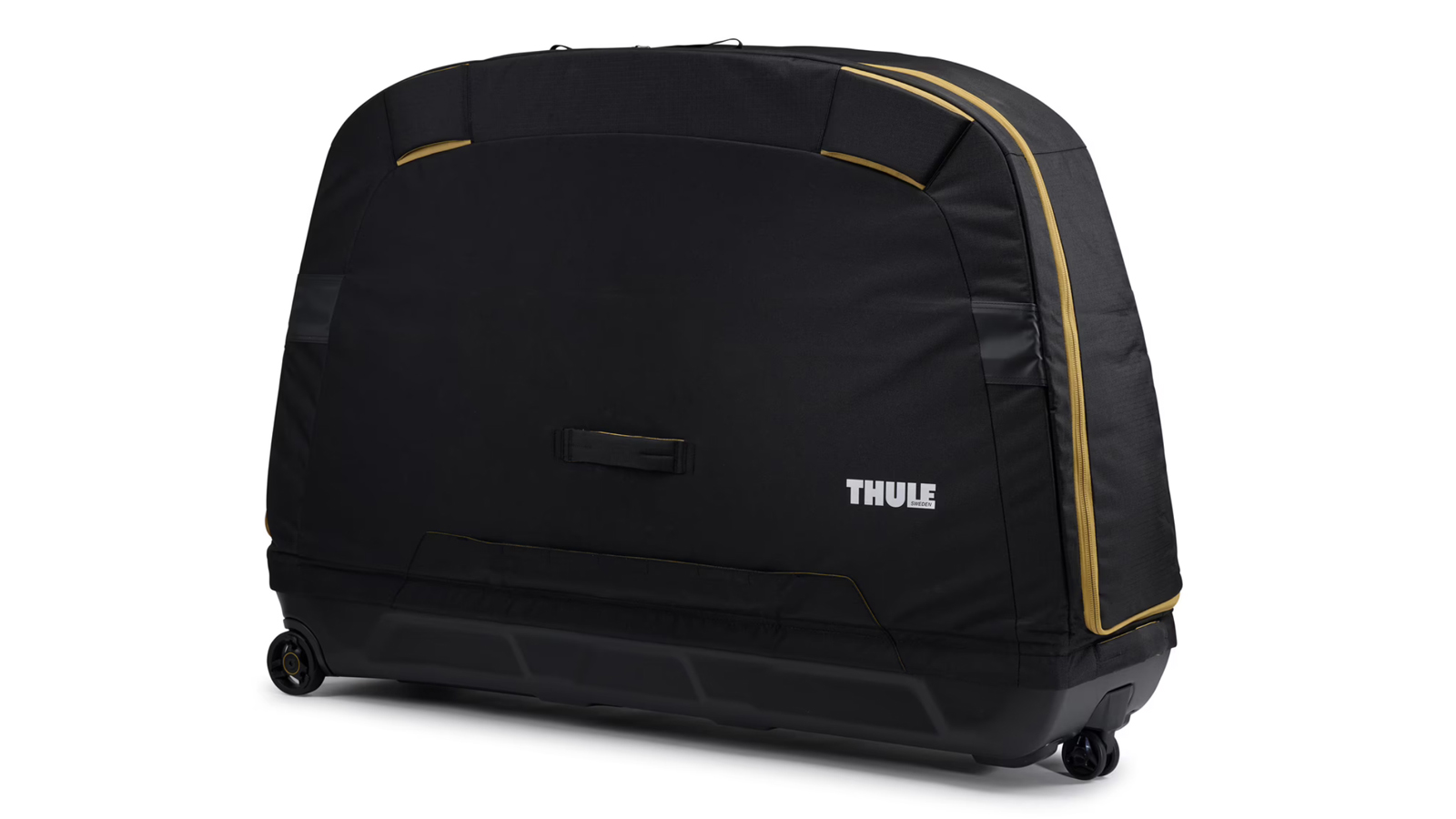
7. Thule Roundtrip bike travel hard case
Specifications
Reasons to buy
Reasons to avoid
✅ You want a small packed size: The Thule bag is easier to store than many alternatives
✅ You want a repair stand too: There's a repair stand built into the case's structure
❌ You want less bike disassembly: Don't forget to pack your torque wrench
❌ You want a lower price: Thule's box is towards the expensive end of the price range
There are some bike travel cases that require a lot of disassembly and others that don't. The Thule Roundtrip Bike Travel Case falls into the category that requires taking things apart but they've been smart to embrace the concept. Parts of the bag that add support and protection come out and assemble into a work stand. There's even a clever triangle that you rotate to match your desired front axle standard.
You can use the work stand to keep the bike supported and at a comfortable working height while you either get it ready to travel or get it ready to ride. It's a good enough work stand that although we have a list of the best bike repair stands, you might be able to get away with a two-for-one purchase if you aren't much of a home mechanic.
Best for low weight
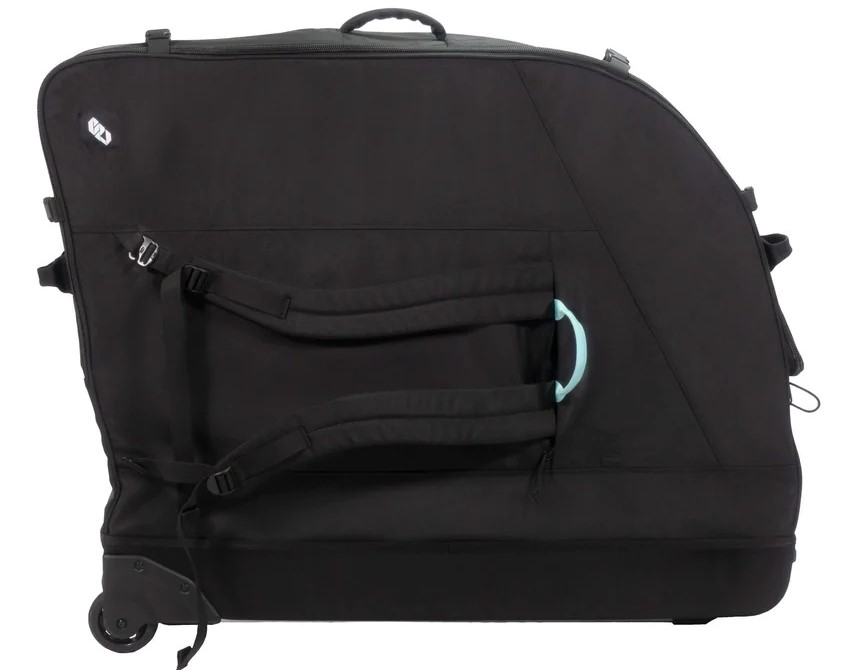
8. OruCase B2
Specifications
Reasons to buy
Reasons to avoid
✅ You want low weight: At 6.8kg, the OruCase is the lightweight winner
✅ You want to avoid oversize fees: The dimensions are also small enough to get you onto many flights without a surcharge
❌ You don't want to disassemble your bike: The flip side of the compact size is a lot of Allen key work
While many airlines are abandoning the extra fees for checking bikes, some still haven't taken note, and that's where the OruCase B2 comes in handy. Travelling with the OruCase B2, when asked by desk agents what's in the bag we've told them everything from massage tables and trade show gear, to 'it's just a really weird duffel bag’ — just make sure you’re not wearing a bike t-shirt, trust us.
The OruCase sneaks in under most airlines’ maximum external dimensions limits for baggage and features plastic armour panels that are backed by foam to keep your ride safe. You'll need to remove your pedals, handlebars, front brake, fork and seatpost, and the bag is still a tight fit, but it comes in two sizes to fit a range of frames.
Weighing in at under 7kg empty, there is plenty of free weight for you to fill the bag with riding clothes (which also work great as extra padding), and there are plush backpack straps to help you get around with minimal fuss.
Best for simplicity
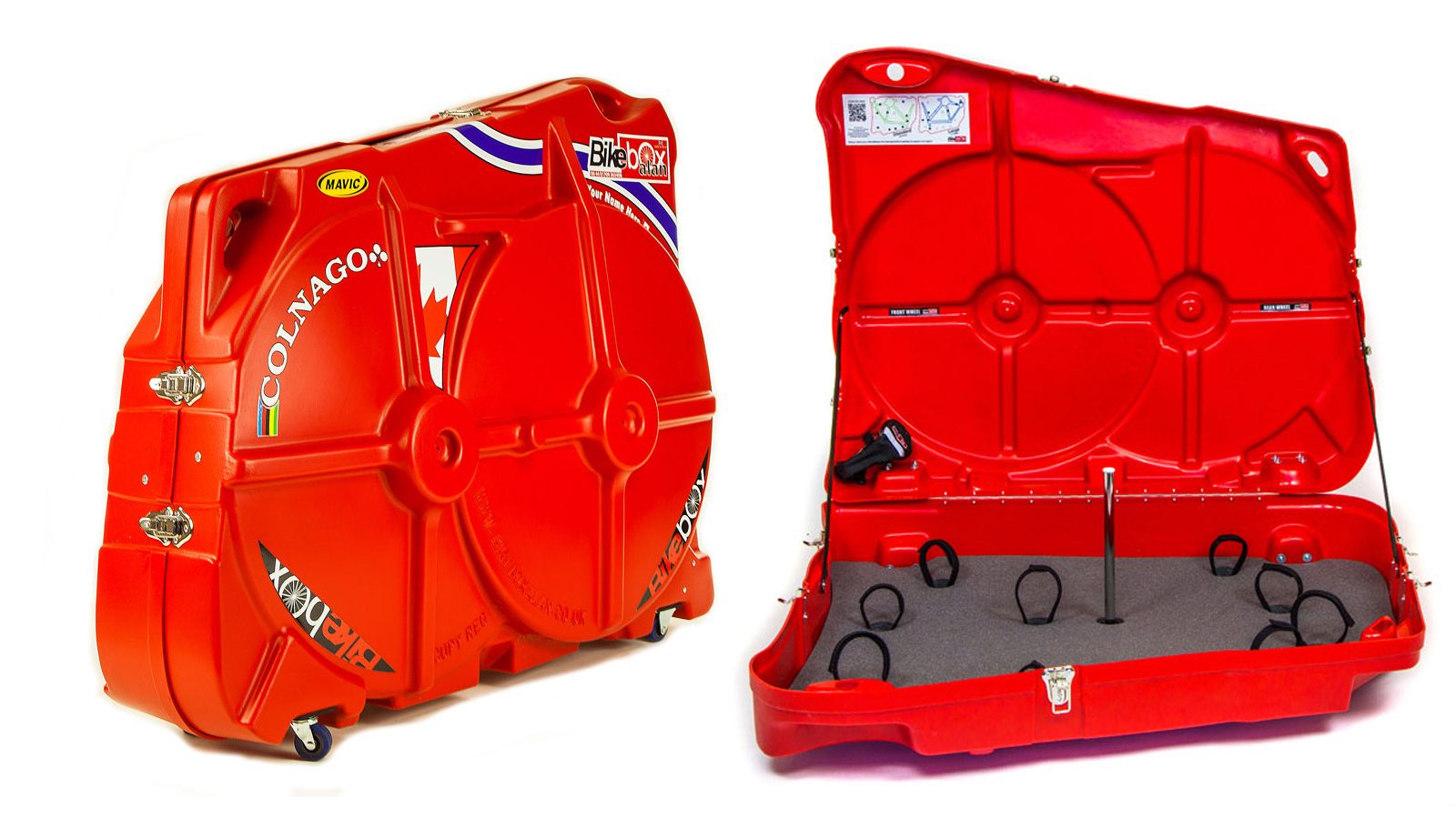
9. Bike Box Alan Original Premium
Specifications
Reasons to buy
Reasons to avoid
✅ You want a sturdy case: The Bike Box Alan is built to last
✅ You want personalisation: Bike Box Alan will add a name and flag for a small fee
❌ You want less disassembly: It's another case that requires hex key work before your bike will fit
❌ You want a lower price: The cost is on the high side for a box with basic features
The Bike Box Alan Premium is a hard case box that claims to fit road bikes up to 65cm in size. Our 58cm test bike had plenty of room to spare, so we're confident the claim is true. It is a super sturdy, hard-wearing box that comes with a seven-year warranty.
The solid plastic case takes the brunt of all heavy-handed impacts while your bike is in transit, and the inclusion of an anti-crush pole prevents lateral pressure on your chainstays and forks, should your chosen airline decide to stack your bike at the bottom of the pile. There is a weight penalty, however - an empty box weighs in at 11.2kg.
Two layers of foam padding prevent damage from within, and the myriad Velcro straps and internal instructions make packaging a straightforward process.
Removal of your handlebars, seatpost, wheels, pedals, and rear derailleur is required, which does take up some of your precious ride time but for the protection on offer, it's a sacrifice worth making.
What to look for in bike bags, travel cases and boxes
There are quite a few considerations when choosing the best bike bag or case for your bike. We'll break these down below, to help you make an informed choice of the best bike bag for your needs.
Hard or soft shell?
Hardshell bike travel cases were the best way to travel with a bike for quite some time. However, engineers at bike brands are pretty clever and softshell bags are now nearly on par for protection, weigh less, and often have removable ribbing so they can be neatly rolled up for storage.
How much does empty weight matter?
With a plastic base, wheels, internal skeleton, and robust materials, bike travel cases are heavy before you put anything inside, and some are pudgier than others.
Most airlines will give you 23kg / 50lbs before they hit you with an exorbitant overweight baggage fee, some budget airlines even less. If your bag weighs 12kg empty, when you pack a 6.8kg lightweight road bike, shoes and a track pump you'll be nudging up against that limit.
What size do I need?
Are you just looking to travel with just your road bikes, or will you be taking trips with your mountain bike too? Are you riding an aero road bike with integrated handlebars or TT bars? Are you riding an XL frame?
These are all things to take into account when shopping for a bike bag because some of the more compact options are simply too small for certain bikes and frame sizes.
Do I need to disassemble my bike?
No bike bag will take your bike fully assembled, but some require considerably more disassembly and mechanical acumen than others. At the very least, you’ll have to pop your wheels off, but some bags also require you to remove your seat post, handlebars, and even the fork.
That's going to cut into riding or relaxing time once you get to your destination and require you to carry more tools to rebuild your bike. A torque wrench is essential if you're going to have to reassemble delicate components.
Travelling with a bike: Frequently Asked Questions
Do I need to worry about wheels and handles?
For something designed to help you move around with a bike in tow, bike travel cases and bike bags can be, unsurprisingly, awkward and cumbersome to move around with.
If you want to avoid a back injury, a set of wheels should be a minimum requirement, especially if you're walking much after you land - some bike bags even use easily replaceable roller blade wheels, as they're prone to damage when being loaded and unloaded.
In addition, you'll want plenty of handles to help you hoist your bag onto a conveyor belt or into the back of a car.
Do I need to remove my derailleurs and rotors?
Take them off. Just about every bike bag out there comes with some sort of protection for your rear derailleur and brake rotors, but airlines have a knack for rendering them ineffective.
Learn from our mistakes and just take them off. The last thing you want is to start your holiday with a bent rotor or a broken derailleur hanger. If you are removing disc-brake rotors, don't forget to put a brake block in the calliper to prevent the pads from sticking together or the pistons from getting stuck - in a pinch, a folded-over business card works, too.
What's the fastest way to get my bike back together?
Saddle height and bar roll aren’t something you often think about until either one is a little bit off, and the last thing you want to do on your riding vacation is to pull over constantly and faff with minor adjustments. A couple of dots and lines with a paint pen will allow you to replicate your preferred position on the bike first try, every time.
Should I add extra padding?
Yes, we have just spent the last few hundred words saying how great the best bike travel cases, bags and boxes are, but there's nothing wrong with a bit of added peace of mind.
Some bags come with foam tubing, however pipe insulation is perfect for an extra layer of protection. You can also pop into your local bike shop, and if you ask nicely, they're likely to have plenty of spare packaging from a newly unboxed bike.
If you have a few spare kilos in your bike bag once it's packed, throw your shoes, riding clothes, bars and gels and whatever else will fit without tipping your bag over the limit. If you've paid for 23kg / 50lbs, you may as well use it, although be aware that some airlines stipulate that a bike bag should contain nothing but your bike.
Do I need to deflate my tyres?
When you’re packing your bike, take a second to let the air out of your tyres. Airlines don’t allow anything pressurised into the cargo hold because it violates civil aviation safety regulations.
Before the engineering types slide into the comments, yes we know that the cargo hold is pressurised to ~10,000ft, which will only add ~3-4psi to your tyres, and it’s extremely unlikely a tyre will burst in transit.
The reason you need to take this step, is because if you do send your bike through with the tyres inflated, there is the distinct possibility that an airline employee will pull your bag aside and attempt to deflate them. At the very least, it'll mean someone heavy-handedly rummaging through your neatly packed case, but we’ve heard horror stories of bags and tyres being cut.
Avoid the drama and just let the air out. If you're running tubeless, drop them to a reasonable PSI that won't result in a sealant shower.
Our top tips for packing your bike
If you need to remove your handlebars, put the faceplate back on your stem so you don't lose the four bolts.
If you need to remove your stem, refit the top cap, then a zip tie around the steerer will keep your fork, headset and spacers from rattling loose. Be careful not to damage the steerer when cutting the zip tie off.
If you have Di2, unplug the battery. At the very least, it'll save some battery life, but it may also prevent your tightly packed derailleurs from shifting in transit and overworking the motor.
If you have an internal seatpost wedge clamp, remove and pack it safely. You don't want to spend the first hour of your trip fishing it out of your frame.
Take a spare derailleur hanger with you. For the price, it's worth having a spare anyway, not least when thousands of miles from home. Some airlines will let CO2 cartridges through, but others will stop the bike and remove them. If you're going to risk it, make them easy to find so the baggage handler doesn't have to empty your entire bag.
Is there anything else I should consider?
If you're using zip ties to hold things in place, you'll need cable cutters or scissors in your case for unpackaging at the other end. You'll also need more ties for the return journey. Maybe pack a screwdriver that'll allow you to undo the zip ties without cutting them. Not only does it save you zip ties, it saves the planet from a little bit of single-use plastic.
Take your tools. If you're having to disassemble your bike to fit it in the box, you'll need to reassemble it at the other end - make a note of the tools used and don't forget to pack them. Especially your torque wrench. You don't want a 90km/h descent of Alpe d'Huez with badly torqued carbon handlebars.
Bottles are a great hardshell for storing potentially damaging things - e.g. allen keys, or items that will pop if crushed - gels, suncream, toothpaste. Wrap them in a carrier bag, though, or you might have oddly flavoured water on your first ride. Shoes are equally useful for this.
If you've got space in the bike bag, wrap your cycling kit in plastic bags and fill the gaps. Not only does this leave room in your other bag, but it will also act as padding.
Don't forget food. Your riding holiday is likely going to involve increased mileage, and speaking from experience, you can't always trust the local tuna sandwich.
How we test
The crew at Cyclingnews is a dedicated group of cyclists who, just like you, care deeply about their bikes. When we travel, we have to trust baggage handlers just like you.
We're lucky to be able to travel a lot in the course of sharing all kinds of relevant cycling technology with you, so we take the opportunity to try out different cases and hope we get a working bike back at the other end.
To test each bike travel case, we carefully go through the packing process to determine how easy it is to pack and unpack a bike. We test this with a range of different bikes to determine if there are any limitations relating to bike type or size.
The real test is actually travelling with a bike and every case we have tested has been passed through the indiscriminate hands of airport baggage handlers to test whether they protect our bikes in transit.
Every experience informs the next and we are sharing a collection of options we think are the best available for a whole range of different needs.
The latest race content, interviews, features, reviews and expert buying guides, direct to your inbox!
Based on the Gold Coast of Australia, Colin has written tech content for cycling publication for a decade. With hundreds of buyer's guides, reviews and how-tos published in Bike Radar, Cyclingnews, Bike Perfect and Cycling Weekly, as well as in numerous publications dedicated to his other passion, skiing.
Colin was a key contributor to Cyclingnews between 2019 and 2021, during which time he helped build the site's tech coverage from the ground up. Nowadays he works full-time as the news and content editor of Flow MTB magazine.
- Graham Cottingham
- Tom WieckowskiTech writer
